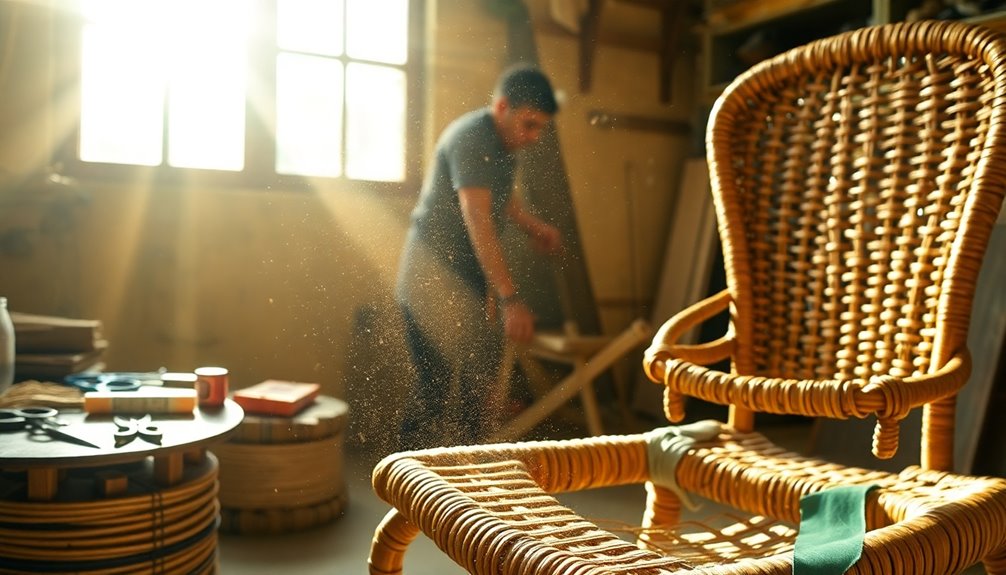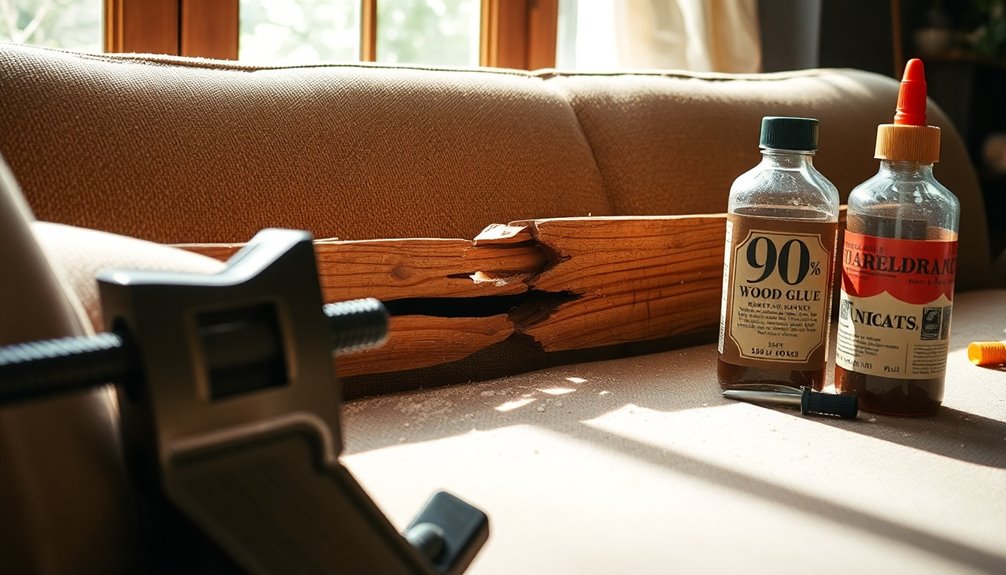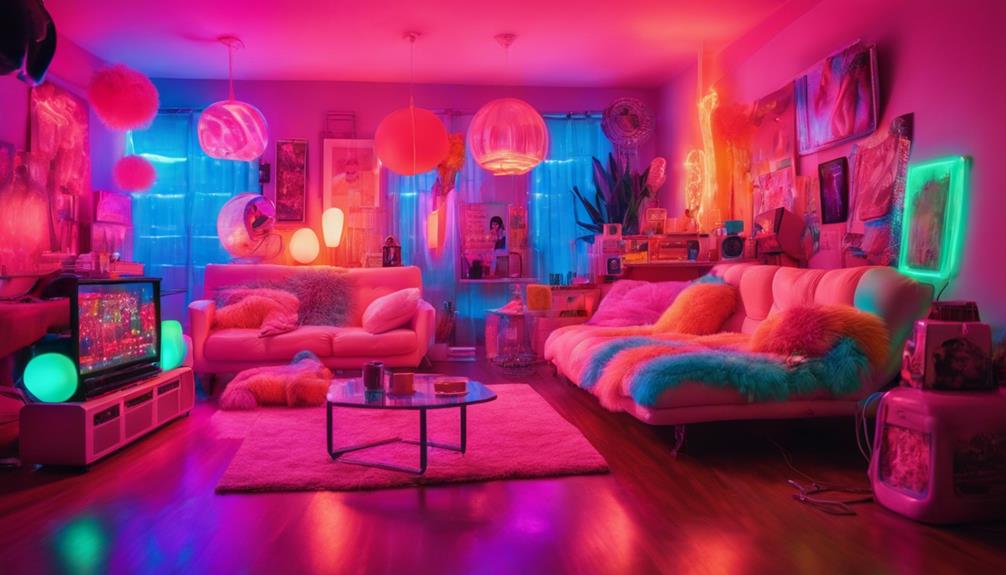To clean cat pee from your sofa, act quickly. Blot the area with a white cloth or paper towel to absorb excess moisture. Rinse the spot with cold water, then apply an enzymatic cleaner to break down the urine. This helps eliminate odors effectively. If you have a fabric sofa, be sure to check the care tag for specific cleaning instructions. After cleaning, allow the area to dry completely to prevent lingering smells. Interested in maintaining your sofa's freshness and preventing future accidents? There are more tips and tricks to keep your furniture in top shape.
Key Takeaways
- Act quickly by blotting fresh cat urine with a white cloth or paper towel to absorb moisture.
- Use cold water to dilute the affected area, then apply an enzymatic cleaner for odor elimination.
- Identify older stains with a black light, marking them for targeted cleaning.
- Ensure cushions and upholstery are completely dry to prevent lingering smells and mold.
- Regularly inspect and maintain your sofa to prevent future accidents and ensure longevity.
Introduction
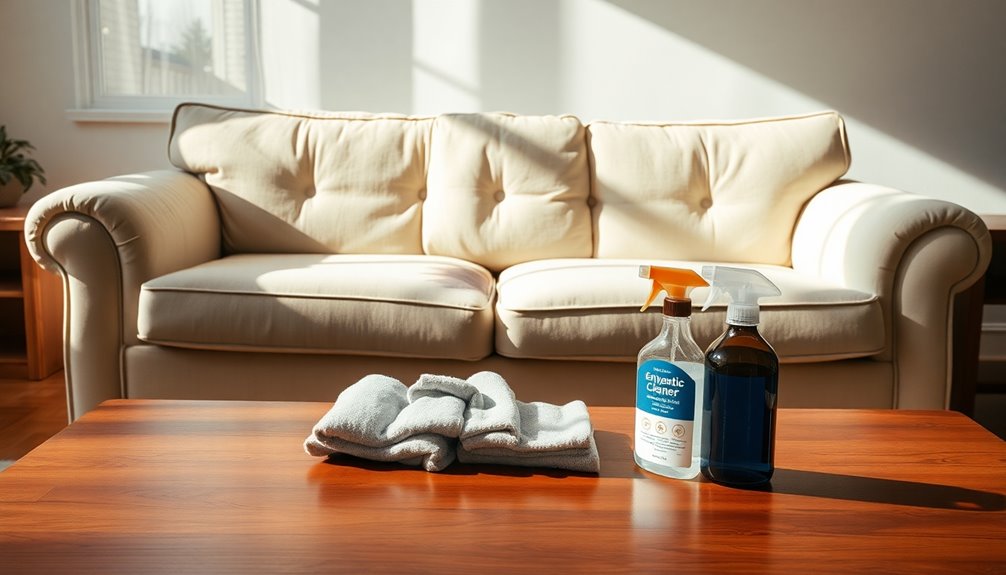
When it comes to cleaning cat pee from your sofa, staying on top of routine inspections is key. Knowing whether your sofa's fabric or leather will influence your cleaning techniques can save you time and hassle. Let's explore how to efficiently eliminate those stubborn urine stains before they become a bigger problem.
Routine Sofa Inspections
Routine sofa inspections are essential for maintaining a clean and odor-free living space, especially if you have a cat. Regularly checking your sofa for signs of cat urine can save you from more extensive cleaning later on. Look for discoloration, odor, or dampness, as early detection is crucial for effective cleaning.
Using a black light can be a game-changer in these inspections. Under normal lighting, hidden cat urine stains might remain invisible, but with a black light, they'll glow a yellow-green, making them easy to spot. Pay special attention to corners and crevices, as these are common areas where cats may urinate.
When you identify any stains, mark them with sticky notes or chalk to keep track of the areas needing treatment. This way, you won't miss anything during your cleaning routine. Incorporate routine inspections into your cleaning schedule to maintain a fresh living environment. By staying proactive, you can help prevent future marking behaviors, ensuring both you and your cat enjoy a comfortable and odor-free sofa.
Fabric vs. Leather Techniques
Identifying the right cleaning technique for your sofa depends on its material, whether fabric or leather. For fabric couches, you’ll want to act quickly. Start by blotting the area with paper towels to absorb as much urine as possible. Then, apply a pet-safe enzymatic cleaner to break down the uric acid and eliminate odors effectively. If you have a microfiber couch, consider sprinkling baking soda afterward to absorb lingering smells, or use a steam cleaner following the manufacturer’s instructions. If your sofa is made of leather, wipe the affected area with a damp cloth to remove any surface residue before applying a leather conditioner to keep the material supple. For both fabric and leather, ensure proper ventilation while cleaning to help remove odor from furniture fabric effectively. Regular maintenance, such as vacuuming and spot cleaning, can also help prevent future odors from becoming embedded in the material.
When it comes to a leather couch, immediate blotting is just as crucial. Afterward, mix a solution of vinegar and water to deodorize the area. However, don't forget to condition the leather afterward to keep it in good shape. For suede couches, sprinkle baking soda to soak up moisture and odors, then carefully use an enzymatic cleaner, avoiding any scrubbing that might damage the fabric. Velvet couches require a gentle touch; dab with a cloth and use a vinegar-water solution, but always check the upholstery tag for specific cleaning instructions. Each material requires its own approach to ensure your sofa stays looking great.
Eliminating Urine Stains Efficiently
Cat urine stains can be a frustrating challenge, but acting quickly can make all the difference. As soon as you notice a fresh stain, grab a white cloth or paper towel. Blot the area and use cold water to dilute it, which helps absorb the urine and prevents the stain from setting. For older stains, shine a black light on your sofa; cat urine glows yellow-green under UV light, allowing you to identify all affected areas.
Once you've located the stains, use an enzymatic cleaner specifically designed for pet urine. These cleaners effectively break down uric acid, eliminating odors rather than just masking them. After cleaning, ensure the area dries completely; use fans or sunlight to help, as lingering moisture can lead to unpleasant smells and mold growth.
To maintain a fresh-smelling sofa, regularly vacuum and consider using baking soda or a cat odor eliminator spray as preventive measures. Consistent upkeep will help you remove cat pee more efficiently in the long run, keeping your sofa looking and smelling clean.
Sofa Stain-Resistant Treatments

When choosing a sofa, consider water-resistant fabric options to help fend off accidents. You might also want to use waterproof throws and protective furniture covers for added security. These treatments can significantly reduce the stress of potential messes from your furry friend.
Water-Resistant Fabric Choices
Choosing the right fabric for your sofa can make a significant difference in how easily you can manage accidents, especially if you have pets. Opting for water-resistant fabrics is a smart choice. Treatments like Teflon or Scotchgard create a protective barrier that repels liquids, making clean-up of pet urine much easier.
Many modern sofas come pre-treated with stain-resistant fabrics designed to resist spills and prevent deep penetration of liquids, minimizing odor retention. Fabrics like microfiber or synthetic blends offer enhanced durability and are less absorbent than natural fibers, which helps to resist staining.
Regularly applying fabric protectors can further extend the life of your sofa by maintaining its resistance to stains and odors, especially in homes with furry companions. However, keep in mind that while these water-resistant treatments assist in cleaning, they don't replace the need for prompt action. Quickly addressing any accidents is crucial to prevent odors from setting in. By choosing the right fabric and using proper treatments, you can enjoy a cleaner, fresher living space, even in a pet-friendly home.
Opt for Waterproof Throws
To protect your sofa from cat urine and other spills, consider using waterproof throws as a practical solution. These throws serve as a protective layer, preventing moisture from seeping into the fabric and causing long-term damage or odors. Many waterproof throws are also made from stain-resistant materials, making cleaning a breeze if accidents happen.
When you opt for machine-washable waterproof throws, you can easily toss them into the washing machine after a spill, ensuring your sofa stays fresh and clean. Regular use of these throws not only safeguards against pet stains but also helps extend the life of your sofa by offering protection against everyday wear and tear.
As you shop for waterproof throws, look for options crafted from breathable fabrics. This ensures comfort while still providing effective protection against moisture. By incorporating waterproof throws into your home, you'll create a more inviting living space while minimizing the risks associated with pet ownership. Plus, you'll feel more at ease knowing you have a reliable barrier against potential messes.
Using Protective Furniture Covers
Adding protective furniture covers can be a smart way to further safeguard your sofa from cat urine and other spills. These covers, made from stain-resistant materials, help prevent liquids from penetrating the fabric, making cleanup significantly easier. When accidents happen, you'll appreciate how these covers can absorb the mess while keeping your sofa safe.
Many sofa covers are machine washable, allowing for convenient maintenance after spills. Regular washing helps maintain their effectiveness and prolongs the lifespan of both the cover and the sofa. Additionally, consider using treatments like Teflon or Scotchgard on your upholstery to create a barrier that repels liquids, further enhancing protection against stains and odors.
Choosing covers with waterproof backing provides added security against moisture from spills or accidents, ensuring your sofa remains in top condition. By investing in protective furniture covers, you not only protect your furniture but also create a more inviting and clean living space. With these simple steps, you'll make dealing with cat pee and other messes a lot less stressful, leaving you more time to enjoy your furry friend's company. Furthermore, using high-quality air purifiers can help eliminate odors and improve overall air quality in your living space.
Upholstery Cleaning and Upkeep
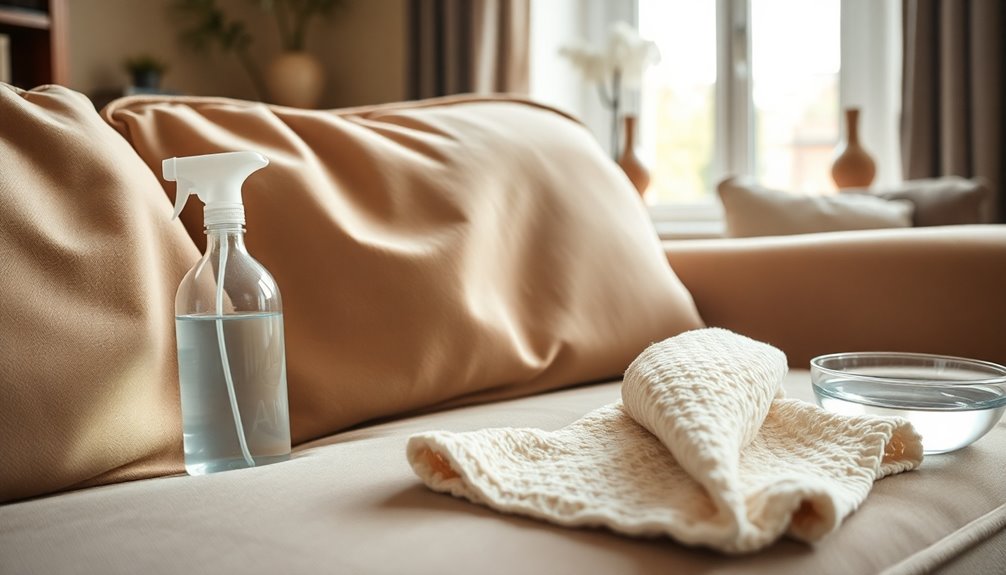
Maintaining your upholstery is key to keeping it looking great and lasting longer. You'll want to pay attention to cushion integrity, use proper leather conditioning techniques, and find ways to revitalize your couch's softness. By staying proactive with these tasks, you can ensure your furniture remains comfortable and inviting.
Cushion Integrity Concerns
While cleaning cat pee from your sofa, it's crucial to consider the integrity of the cushions. If urine seeps deep into the foam, it can compromise the cushions and lead to permanent damage. To prevent this, act quickly with an appropriate cleaner. Different fabrics require tailored cleaning methods—microfiber can handle steam cleaning, while leather should only be cleaned with gentle blotting and vinegar solutions.
Using protective covers on your cushions can help shield them from accidents and make cleanup easier, preserving their original condition. Regular inspections are also essential. Check for hidden stains or odors that might have developed over time. Catching these issues early allows you to address them before they cause deeper damage. Additionally, maintaining a clean and safe environment around your furniture can prevent further accidents and damage.
Leather Conditioning Techniques
To keep your leather sofa looking its best, regular conditioning is essential. After cleaning any stains, including cat pee, you should apply a leather conditioner to restore moisture and prevent cracking. Choose a conditioner specifically designed for leather upholstery to ensure it works effectively.
Begin by applying the leather conditioner using a soft, lint-free cloth. Work it into the leather in a circular motion to guarantee even coverage and absorption. It's crucial to allow the conditioner to sit on the leather for at least 10-15 minutes. This waiting period helps the product penetrate the material properly. Once the time is up, buff the surface with a clean cloth to enhance shine and remove any excess conditioner.
For optimal care, aim to condition your leather sofa every 3-6 months. This routine not only prolongs the life of your upholstery but also keeps it supple, reducing the chances of stains from accidents. Before applying the conditioner to the entire sofa, always test it on a small, inconspicuous area to ensure compatibility with your specific type of leather.
Revitalizing Couch Softness
After ensuring your leather sofa remains well-conditioned, it's time to focus on revitalizing the softness of your couch upholstery. Start by regularly vacuuming your sofa with an upholstery brush attachment. This helps eliminate dirt and pet hair, keeping the fabric soft and preventing odors from settling in.
Next, consider using a steam cleaner periodically. This method refreshes upholstery fibers, helping restore their original texture while disinfecting the surface. After cleaning, applying a fabric protector can be beneficial. It repels future stains and maintains softness by creating a barrier against spills.
If you have delicate fabrics like velvet or suede, it's wise to enlist professional cleaning services. They specialize in upholstery and will ensure the softness is preserved without causing any damage.
Don't forget to maintain a consistent cleaning schedule. Make spot treatments for stains and odors a priority, as this can greatly extend the life and softness of your couch. Additionally, sprinkling baking soda on the upholstery can help absorb any lingering smells. Following these steps will keep your couch looking and feeling great for years to come.
Furthermore, investing in a top-rated vacuum can enhance your cleaning routine by ensuring deep cleaning of your upholstery.
Custom Couch Covers Selection
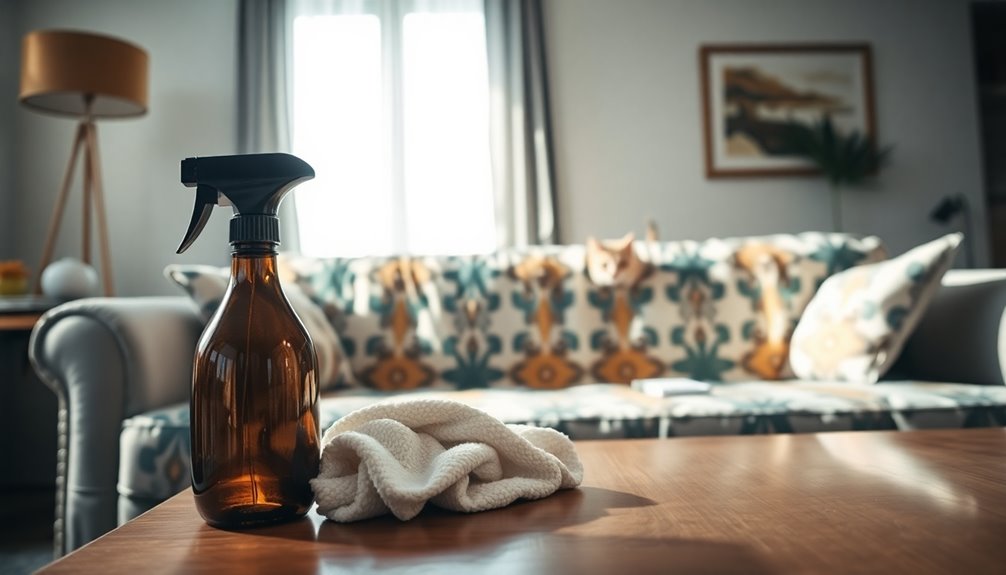
Selecting the right custom couch cover is essential for protecting your furniture from cat pee and other accidents. Custom covers can be tailored to fit any sofa style, ensuring a snug and attractive fit. Look for covers made from durable, water-resistant materials that are easy to clean and maintain, providing an extra layer of protection against pet accidents.
When choosing a custom cover, consider options with removable and machine-washable features. These will make your life easier when it comes time for cleaning and maintenance after any mishaps. Opt for designs that incorporate pet-friendly fabrics, which resist scratches and are simple to wipe down. This reduces the chances of odors lingering in your upholstery.
Additionally, think about personalization options like color and pattern choices. You can keep your home decor intact while safeguarding your furniture from potential damage caused by your feline friend. By selecting the right custom couch cover, you'll not only protect your investment but also create a pet-friendly space that looks great and stands up to the challenges of pet ownership.
Routine Deep Cleaning Schedule
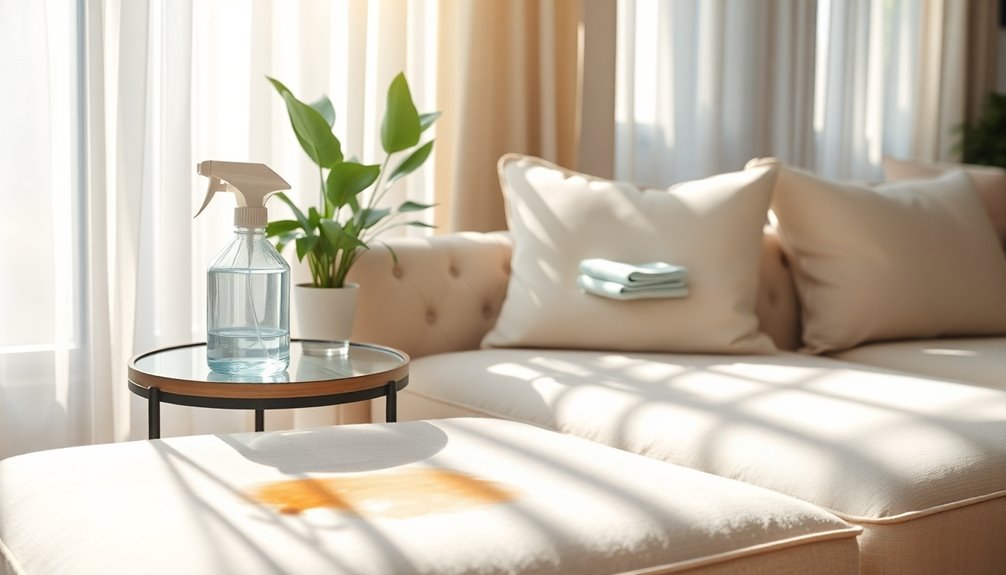
Keeping your sofa protected with a custom cover is just the first step; maintaining its freshness is equally important. Establishing a routine deep cleaning schedule is crucial for getting rid of any lingering cat smell and ensuring your sofa stays in great shape. Start by vacuuming your sofa at least once a week to prevent odor buildup and keep the fabric intact.
Every 3-6 months, schedule a thorough cleaning with enzymatic cleaners, especially if you have pets. These cleaners effectively eliminate any accidents' odors, so your sofa remains fresh. On a monthly basis, apply baking soda to absorb persistent smells; let it sit overnight before vacuuming it up.
Don't forget to plan for seasonal deep cleanings, ideally hiring professional services at least once a year. They can tackle stains and odors that regular cleaning might miss. Keep a log of cleaning dates and methods used to track effectiveness. This way, you can adjust your routine deep cleaning schedule based on recurring issues with pet accidents, ensuring your sofa stays inviting and odor-free.
Conclusion

Cleaning cat pee from your sofa is essential for maintaining a fresh and inviting living space. If you don't address the issue promptly, the urine can seep into the upholstery, leading to long-term odors and potential damage. Start by using an enzymatic cleaner specifically designed for pet urine; this is crucial since these cleaners effectively break down uric acid and eliminate odors.
When you discover a stain, blot the area immediately with a clean cloth or paper towel to absorb excess moisture without spreading the stain further. Regular inspections and deep cleaning of your sofa can help identify hidden stains, preventing persistent odors from developing.
It's also important to implement preventive measures to reduce future accidents. Ensure your cat has enough litter boxes and address any behavioral issues that may contribute to inappropriate urination.
Frequently Asked Questions
How Do You Clean a Couch That a Cat Has Peed On?
To clean a couch that's been soiled, start by blotting the area with a clean cloth to absorb as much liquid as possible. Then, use an enzyme-based cleaner, following the product instructions for optimal results. If you prefer a DIY method, mix equal parts white vinegar and water, apply it, and blot afterward. Finally, sprinkle baking soda to absorb any lingering odors, let it sit, and vacuum it up once dry.
How Do I Remove Urine Smell From My Couch?
To remove urine smell from your couch, start by blotting the area with a clean cloth to absorb excess moisture. Then, apply an enzymatic cleaner designed for pet odors, letting it soak in. If you prefer a natural method, mix white vinegar with water, apply it, and blot afterward. Finally, sprinkle baking soda over the area to absorb any lingering smells, letting it sit before vacuuming. Repeat if necessary for stubborn odors.
Will Cat Urine Smell Ever Go Away?
Yes, cat urine smell can go away, but it depends on how quickly you act and the methods you use. If you address the issue promptly with the right cleaners, like enzymatic solutions, you'll have a better chance at eliminating the odor completely. However, if the urine seeps into deeper layers, it might linger longer. Regular maintenance and immediate cleaning can help prevent persistent odors and keep your home smelling fresh.
What Neutralizes Cat Urine on Fabric?
To neutralize cat urine on fabric, you've got a few effective options. Try using an enzymatic cleaner specifically designed for pet stains, as it breaks down uric acid and tackles odors. A mixture of white vinegar and water can also help; the acidity neutralizes the smell. Don't forget about baking soda, which absorbs odors well. Just sprinkle it on and let it sit overnight for the best results. Avoid ammonia-based products, though!

